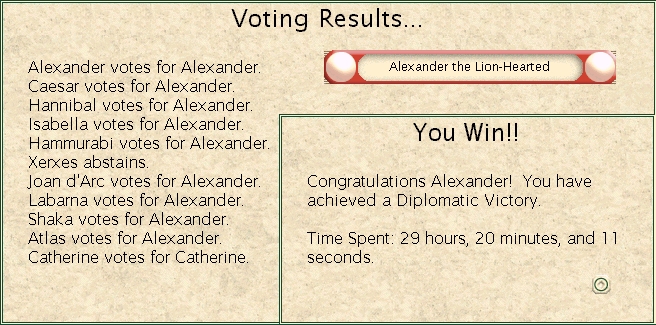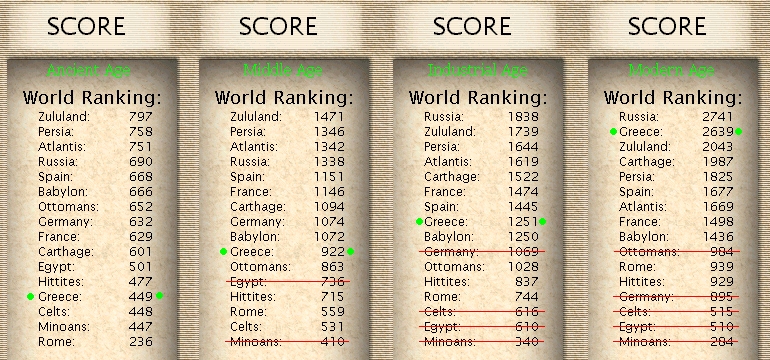Originally posted by KELLO
What was your score in the end, just out of interest?
I like to hold it back for some suspense till the final results ... for now I'll just say I got over 9000 Jason

Originally posted by Dianthus
SirPleb, could you quantify "superior numbers"? Last month I had to attack the French Infantry with my Cavalry in non-superior numbers, relying heavily on Artillery to weaken them instead.
Originally posted by rabies
I feared building too big an army in republic to keep conquesting...it seems my fears were unwarrented. I too would like to know how many units you were supporting. I also regret stopping for a solid 20 turns to wait for tanks now to take on riflemen. I should have just charged. Were the cavalry completely unassisted by the use of artillery/cannons? Even with tanks, I was taking some substantial losses...causing war weariness to take effect.
Yes, the Cavalry were completely unassisted.
I've checked a couple of saves:
At 670AD when I shifted to Cavalry I had 49 of them, plus 81 workers, plus probably about the same number of captured workers.
At 950AD I was near my peak size. I don't think I built Cavalry after that. I then had 113 Cavalry, 86 workers, and probably 100 or so captured workers. I think I'd started joining some workers to towns then, probably peaked a bit earlier at near 100 Greek workers.
Although I of course lost many Cavalry, production was huge and I netted quite a gain over that period.
In terms of the number of units to attack a city, I didn't often face that as a decision. My approach was to start with as large a group as possible and use them all on the same targets. Each turn during a war I would:
o Group all my healed Cavalry.
o Attack a city they could reach from my territory on the same turn.
o Railroad up to the newly captured city. About half my total worker force was dedicated to supporting the war, so that I could do this immediately upon taking each city.
o Repeat the process taking another enemy city.
I'd stop when I either
a) Couldn't reach any more cities on the same turn. In this case I'd move a stack or two into positions to take cities next turn. (Selecting them so that immediate routes to further cities would be opened up.)
b) Didn't have enough healed units left to take another city. The remaining unused units would then move to defend exposed units near the front line.
When I did need to decide in advance how many units were enough (for two turn attacks, or when deciding to end a turn) my general thinking was that "enough" would be between:
o 5 or 6 units for a small town defended by muskets at the lower extreme.
o 20 units for a city defended by infantry at the high extreme. (This wouldn't be enough in a game where the AIs were really strong. But in this game they didn't have large defense forces.)
A few keys to this approach are the fast tech pace, keeping the AIs broke, and using lightning strikes. These things seem to all help to keep the AI's military weak:
The fast tech pace seems to keep the AI busy working on infrastructure to catch up. (It also helps that they don't go to a war footing with anyone.)
Keeping the weaker AIs (the ones I'd prefer to take over, I want the stronger ones doing research) broke means they can't upgrade their obsolete units when war comes.
A lightning strike results in them having no time to shift to a war footing and build up defenders.
Another important thing is to try to avoid attacking cities until you're fairly sure you can take them on the same turn. If you don't take the city after beginning an attack, you'll have many units in enemy territory. That will increase war weariness and will often leave some weakened units exposed to counter-attacks.
I preferred using Cavalry over Tanks in this situation because of war weariness as well as for the better ability to use lightning strikes. I had some war weariness but it was not a problem because: 1) Wherever possible I used the 3-move of Cavalry to take cities from a starting point outside their boundary, i.e. minimized the number of units inside enemy territory. The worst cases were invading the other continents, landing 20 Cavalry inside the enemy zone on the first turn to ensure taking one city as a beachhead. There were also some cases where the rough terrain meant leaving a number of units in enemy territory for one turn while approaching a city. 2) All of my productive core towns were size 12 with Marketplaces and 8 luxuries. So even a fairly high level of war weariness (which I reached in the last turns of a couple of wars) didn't hurt productivity - all citizens could still work, the weariness was only affecting score for a short time.
I found that Cavalry worked surprisingly well. Losses were high but not as high as I'd anticipated. Partly because the opposition was weaker than I expected. And partly because I had a lot of elite Cavalry from early action against weak enemy units. An elite Cavalry is not just a bit stronger - it also benefits from better odds of getting a retreat roll. Eventually I lost many of the elites since I always used them as my front line, but they did a lot of damage while I had them.
Originally posted by oinland
Fantastic idea to use the two best ai as "research institutes" with you financing them!
I was strongly motivated

- I knew that Bremp was 6 turns ahead of me and really wanted to find some way to catch up. And now I see that you were 7 turns ahead! Phew, what a close finish!

Originally posted by Drazek
How do you balance your building so that you have 4t research rate as well? Do you count your beakers and the needed ones so that you won't build/rush "unnecessary" banks at the time for example.
You can count beakers but it is a bit complicated. There's a nice description of research costs in
this thread by mydisease. Factors include map size, difficulty level, and the number of Civs who have discovered a tech. (When staying ahead in research the last factor doesn't matter of course.)
On this particular map research costs were fairly high overall. The huge map setting for the science multiplier was the big factor in this.
I use an approach I find simpler than calculating beakers. There's a fixed basic research cost for each tech which is multiplied by the other factors. I downloaded a text file containing the base costs some time ago from a CFC thread, I'm sorry but I can't find that thread now. You can see the base costs in the map editor, and they're also listed in
Ambiorix's spreadsheet, on alexman's
"what will the AI research next" thread.
What I do is, once I've reached a four turn rate, I calculate how long a given base cost is taking me at a given research percentage. For example, suppose I'm learning Astronomy and I'll need to research at 80% to get it in four turns. Astronomy's base cost is 56, so I'm learning 14 units/turn. If I were to boost my rate to 100% that would be a multiplier of 1.25 (1.0 / 0.8) So, at 100% I can currently learn a 56 * 1.25 = 70 unit tech in four turns. Anything higher I won't be able to do in four turns.
I then look ahead to see what costs are coming up. If I'm going to finish the Middle Ages in five techs (20 turns) then I need to be thinking ahead to the coming jump in research costs. A number of early Industrial techs are cost 120. My capacity needs to be boosted a LOT (from 70 to 120) over the next 20 turns - time to panic and devote all efforts to increasing science. OTOH if in the same situation I could learn Astronomy in four turns at 50%, I'd realize I'd been over-building for science, could have been building other things - I'm already nearly able to handle the 120 cost I'll face in 20 turns.
When going for a maximum science rate I use this looking ahead to decide on an onging basis how much effort should go toward increasing research capacity and how much can be used for other things. In the above example if I could get Astronomy in four at 60% or 70% I'd feel that the situation was under control.
There are a lot of things to do to increase your science rate. They vary somewhat depending on the specific situation. The following general guidelines, though not absolute, might be some help. I've tried to put these roughly in order of priority as I see them:
o Get to Republic as soon as practical. (Happiness considerations and army size may sometimes affect this decision but shouldn't often be reasons for delaying.)
o Get a second productive region ASAP (Forbidden Palace or Palace jump.)
o Road all tiles which citizens are assigned to.
o Build libraries.
o Keep all citizens in non-corrupt cities productive, no specialists. This usually means making an effort to gain luxuries and also means building Marketplaces at the size 6 to 9 range.
o Build universities.
o Increase population in all non-corrupt towns.
o Build harbors, and later on commercial docks, in non-corrupt coastal cities.
o Build courthouses and police stations in any productive city with more than a few gold lost to corruption. The higher the percentage it is losing to production, the higher the priority of building these in the city.
o Build science wonders (Copernicus, Newton's) in cities with high science potential. You want cities with lots of gold bonus tiles for this.
o When a core city does not have a priority build pending (i.e. you don't urgently need anything particular to be built there) reassign its citizens from high shield tiles to high gold tiles. Especially do this with cities which have your science wonders.
o If in a panic situation you need to squeeze just a bit more research to get something down to four turns, reassign citizens in corrupt cities to be scientists, and/or reassign citizens near the core to higher gold tiles.
And finally, two of the most important considerations:
1) Try to be rich enough to research at 100% when you need to. Sometimes you can save up gold in advance for a tough stretch and run at a deficit for a while. In this particular game with so many rivals, I found I could get plenty of cash from the Civs I wasn't setting up as research helpers, had no problem running a cash surplus at all times.
2) Consider using your Golden Age to boost through a critical research period. I.e. one where techs take a big jump in cost and you won't be able to do them in four turns. The Golden Age can help you to make the new rate for 20 turns, and to also build up more research infrastructure during that time so that you'll be on top again when the GA ends.

 .
.


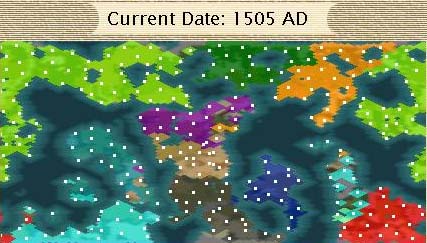
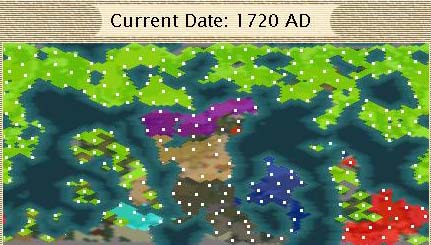
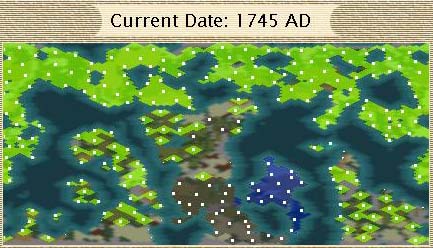


 ).
).






 ): it was 1884AD when Athens reached the 20k culture mark. Greece was worth 4808 firaxis points at that point. My finish wasn't half as close as Mad's (you can find his account
): it was 1884AD when Athens reached the 20k culture mark. Greece was worth 4808 firaxis points at that point. My finish wasn't half as close as Mad's (you can find his account ![PTW Icon [ptw] [ptw]](/images/smilies/ptw.gif) v1.21f, Open
v1.21f, Open
